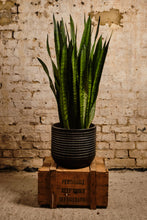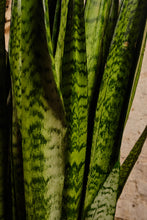This plant is only available for local delivery or click and collect. To see our list of local delivery postcodes please click here.
Pot size: 30cm x Plant height: 95cm approx
Fits a pot with a 32cm - 36cm diameter.
*Pot in image not included in price
About
Sansevieria trifasciata, commonly known as the Snake Plant, are one of the easiest plants to care for. They're also excellent air purifiers, removing household toxins such as formaldehyde and benzene from its surroundings.
Light: Direct, bright but indirect, or shade
Sansevieria will tolerate any light level so long as there is some natural light in the room. Bright light will see them put on the most visible growth, but they will survive in deep shade too.
Watering: Low
The only sure way to kill a sansevieria is to overwater it - make sure to let the soil fully dry out between waterings. How often you water will depend on the amount of light its getting so be sure to check the soil has fully dried out by testing through the drainage hole at the base of the pot.
Humidity: Low or high
It can tolerate most levels of humidity found in the home, including areas with very dry air or a strong draught.
Note:
Sansevieria are one of the few plants that like having compact roots so re-potting should be done very infrequently. Make sure to use a cactus soil or other free draining compost and plant into a pot with a drainage hole. Feed your Sansevieria during Spring and Summer to make up for the loss of nutrients that would usually come with fresh compost.




